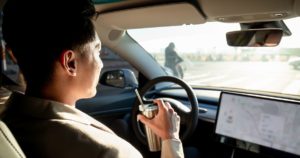Self-Driving Vehicles: Questions of Safety and Liability
January 6, 2023 In the last 10 to 15 years, developers and automobile manufacturers worldwide have funneled nearly 100 billion dollars into the development of self-driving, or automated, vehicle technologies. Although many proponents claim that automated vehicles will significantly reduce roadway fatality and injury rates in addition to decreasing traffic congestion, the technology is still largely in its developmental phase. There are two especially important questions when it comes to self-driving vehicles: is their technology as safe as it promises to be and who, or what, is legally responsible when an accident happens?
In the last 10 to 15 years, developers and automobile manufacturers worldwide have funneled nearly 100 billion dollars into the development of self-driving, or automated, vehicle technologies. Although many proponents claim that automated vehicles will significantly reduce roadway fatality and injury rates in addition to decreasing traffic congestion, the technology is still largely in its developmental phase. There are two especially important questions when it comes to self-driving vehicles: is their technology as safe as it promises to be and who, or what, is legally responsible when an accident happens?
Automated vehicle technologies might not be advanced enough to make them regular fixtures on roadways across the globe just yet, but developers are undoubtedly racing to have their multi-billion-dollar investments pay off. A senior state affairs counsel for the American Academy of Justice (AAJ), Daniel Hinkle, says his primary concern is that developers will find ways to deploy models on our streets not because they are safe enough to be in the hands of the public, but because they have used legal loopholes that limit their liability if – and when – an accident happens. As senior counsel for the AAJ, Hinkle works with state attorneys on issues that affect the civil justice system. Considering that legal regulations that follow new technologies, like automated vehicle technologies in this case, tend to be about 10 years behind, Hinkle’s concerns make a lot of sense.
Products liability experts say that there will need to be a significant development in the law in order to account for the increase in partially and fully-automated vehicle systems on the road. Legislators will have to answer questions like how liable the person sitting in the front seat can be and for which points of the accident they can be found liable (for example, whether the driver can be found responsible for the collision itself or only for acts like failing to engage fully in the moments leading up to the accident). Legislators will also have to determine how liable vehicle and driver assist system manufacturers are. Unsurprisingly, it will take time to answer these complex legal questions.
Safety Issues to Consider
Recently, the National Highway Traffic Safety Administration (NHTSA) launched two investigations into crashes involving partially-automated Tesla vehicles. The federal agency currently has more than 40 pending investigations against the automobile manufacturer. Tesla’s automated vehicles are by no means the only makes and models that have been implicated in deadly collisions and crashes in the last few years. We have compiled some other examples of noteworthy accidents and safety issues below:
- Motorcyclists were involved in the most recent two crashes that the NTHSA is investigating. In both instances, the individuals on motorcycles were killed by a partially-automated vehicle. The crashes had a few other things in common as well, including that they occurred at nighttime when it was dark outside, that the vehicles struck the motorcyclists from behind, and that each most likely involved the use of partially-automated driver assist systems. Safety experts worry that these examples may indicate that Tesla’s vehicle do not account – or stop for – motorcyclists.
- In 2018, a female pedestrian in Tempe, Arizona, was struck and killed by a self-driving Uber vehicle. Although there was a backup safety driver in the driver’s seat, sources say she was looking at her cellphone when the collision happened. The NHTSA investigated the incident and determined that the driver assist technology was defective because it was unable to accurately identify objects on the road and would also engage in phantom braking, or slamming on the brakes suddenly. Instead of fixing the technology involving the phantom braking phenomena, Uber simply made its vehicle unable to come to hard stops altogether, which causes a variety of other safety hazards to worry about.
Consumer and product safety advocates say that one of the best ways to navigate this new legal landscape is by having vehicle manufacturers engage in good faith communication about issues of liability instead of hoping to place all the blame on drivers. To put it plainly, manufacturers should be responsible for the systems they create and promise are safe. Some states are already implementing laws to address this issue. In Louisiana, for example, individuals who are going to own and/or operate automated motor vehicles must register with the Department of Transportation (DOT). The manufacturer of the vehicle also must register as a driver with the state’s DOT.
We will keep you updated as this novel legal issue continues to develop. In the meantime, if you were involved in an automobile accident and you have any questions about filing a legal claim, our firm can help. To learn more, contact a representative online now.
Philadelphia Products Liability Lawyers at Galfand Berger, LLP, Representing Injured Victims Since 1947
If you have a question about filing a legal claim, contact the Philadelphia products liability lawyers at Galfand Berger LLP today. Call us at 800-222-USWA (8792) or fill out our online form for a free consultation. Located in Philadelphia, Bethlehem, Lancaster, and Reading, we serve clients throughout New Jersey and Pennsylvania, including Allentown and Harrisburg.
 Google Screened
Google Screened
